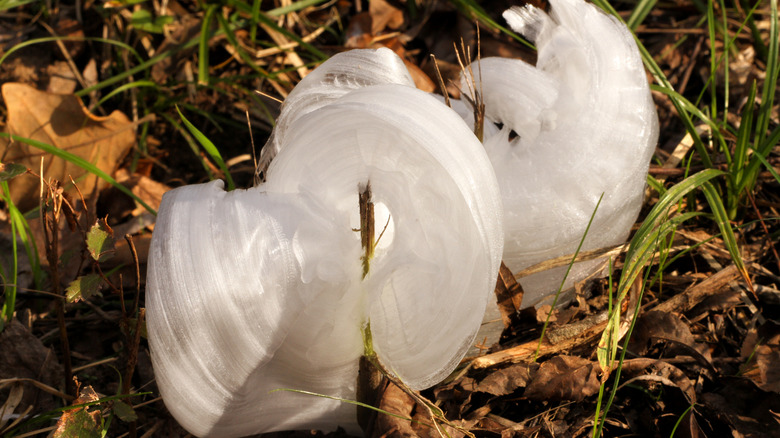The Fascinating Natural Element That Might Pop Up In Your Yard As Temperatures Drop
After you winterize your lawn, bring your plants inside, and get rid of debris before the first frost, there's not much else to do in your yard until spring comes. But that doesn't mean your yard has nothing of interest in cold weather. On the contrary, winter brings some fascinating natural phenomena — and no, we're not talking about snow. One rare phenomenon that pops up as temperatures drop is "frost flowers."
Frost flowers aren't flowers at all, but are botanical wonders of a different sort. They're paper-thin layers of ice that protrude from certain plant stems when the conditions are just right. Sometimes they look like flowers; other times, they look like curling or winding ice sculptures.
Unlike real flowers, you don't have to do any gardening to get frost flowers to bloom. And there's not much you can do to get them to last longer, either. They typically only appear for one morning a year. But if you keep an eye out in your yard and know where to look, you might just be able to catch this unusual sight for yourself.
Where to look for frost flowers
Frost flowers form when the air is below freezing, but the ground is not — typically late autumn or early winter. The plant's sap freezes, expands, and bursts through thin cracks along the stem. Water moving upward through the stem then exits through the cracks and freezes as it hits the air, resulting in icy ribbons known as frost flowers. Like a snowflake, every frost flower is unique. On large plants, they can get up to six feet tall.
Only certain plants form frost flowers, possibly because the root systems remain active later in the season. They're most common on yellow or white wingstem plants, such as white crownbeard and yellow ironweed. Others include American dittany, longbranch frostweed, and stinkweed. While frost flowers may occur on other plants as well, the phenomenon is so closely associated with these plants that the term "frostweed" often appears in their nicknames.
Wingstems grow throughout the US, typically in meadows, woodlands, and grassy clearings. For frost flowers to form, the soil must be moist or wet, and the plant's stem must not have previously frozen. These icy structures often form by tall weeds in less maintained areas of the yard. By the time the sun comes out for the day, they will start to melt, so waking up early is key to spotting them.

